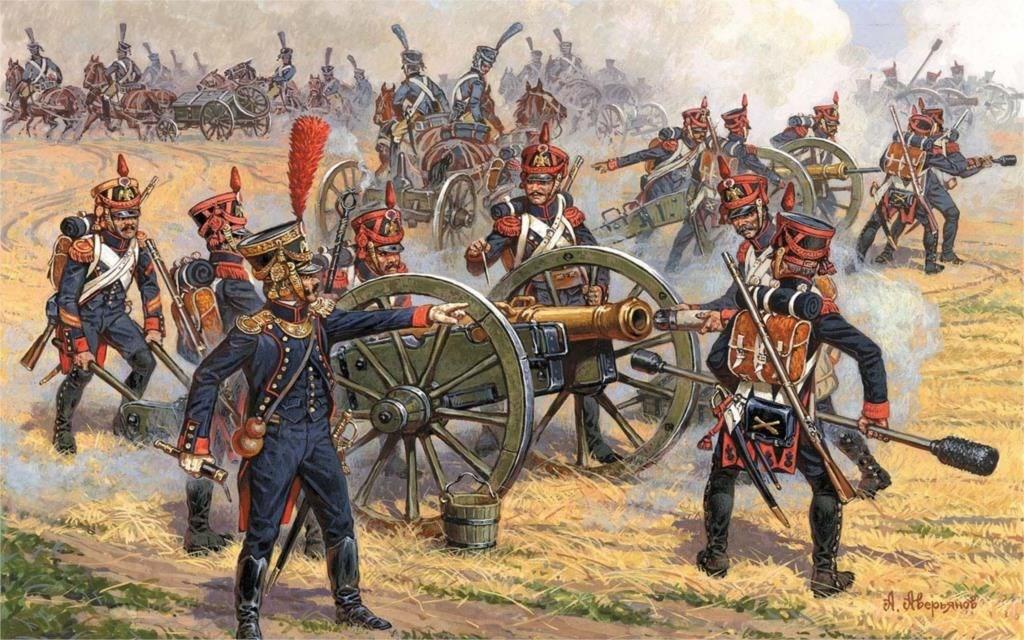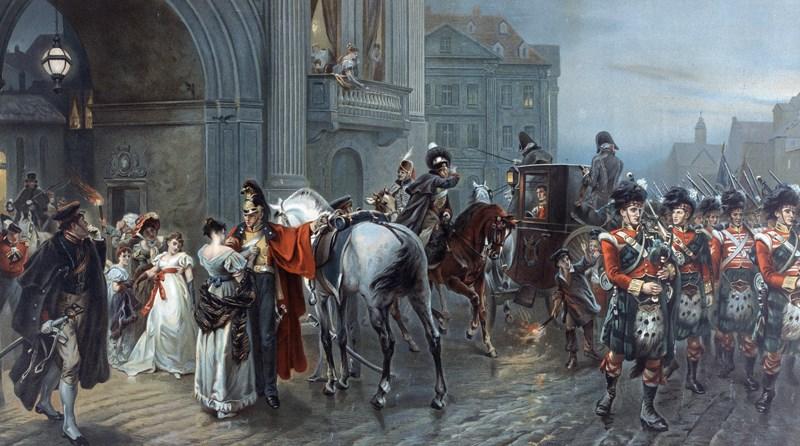
9 minute read
Peter/Petrus Rene Pauli 1792—1884

The Imperial Guard was a small, elite army, directly under Napoleon's control. Like the corps, it had infantry, cavalry and artillery. It was comprised of the best veteran soldiers from every theater of war – Egyptian Mamluks, Italians, Poles, Germans, Swiss, and others, as well as French.
The Guard was made up of Napoleon's finest. They were the most seasoned soldiers of the French army and the best of his elite Imperial Guard. All were hand-picked volunteers of above-average height, each one hardened by years of campaigning. By the time of Napoleon's invasion of Russia in 1812, it had swelled to just under 100,000 men
As can be seen above, Peter Pauli was one of Napoleon’s Imperial Guards. He fought with Napoleon’s Army in the battle of Waterloo.
Napoleon and the Battle of Waterloo
The Battle of Waterloo was fought on 18 June 1815 between Napoleon's French Army and a coalition led by the Duke of Wellington and Marshal Blücher. The decisive battle of its age, it concluded a war that had raged for 23 years, ended French attempts to dominate Europe, and destroyed Napoleon's imperial power forever. The adverse environmental conditions, the weak state of his army, the incompetence of his officers, and the superior tactics of his enemies all forced Napoleon to wage war from a disadvantageous position and eventually led to his demise.
Fought near Waterloo village, Belgium, it pitted Napoleon's 72,000 French troops against the duke of Wellington's army of 68,000 (British, Dutch, Belgian, and German soldiers) aided by 45,000 Prussians under Gebhard Leberecht von Blücher.
The battle of waterloo was a devastating event for the armies involved as well as the village itself. The combined number of men killed or wounded reached nearly 50,000, with close to 25,000 casualties on the French side and approximately 23,000 for the Allied army.
Out of 60,000 horses on the field of battle that day at least 7,000 were killed or wounded, with at least one estimate putting the figure as high as 20,000
The Battle of Waterloo brought an end to the Napoleonic Wars once and for all, finally thwarting Napoleon's efforts to dominate Europe and bringing about the end of a 15-year period marked by near constant warring.
Various sources
The Soldiers Life – PBS Wisconsin
Most of the men in Napoleon’s Grand Armée were conscripts drawn from the poorer classes. Every ablebodied man of age in France was expected to willingly join the ranks to defend the Republic – or risk losing citizenship. In theory soldiers were eligible for discharge after five years, but after 1804, most discharges were only for medical reasons. Most new soldiers received little training, and had to learn their trade on the battlefield.
Supplies were usually scarce, since Napoleon’s armies traveled with small logistical trains to improve mobility. Uniforms were often ill-fitting and uncomfortable. Boots rarely lasted more than a few weeks. Soldiers learned by experience that marauding was often a more reliable source of food, horses and other provisions than the army’s supply system. Often hungry and eager to fight for the glory of France and their emperor, Napoleon’s soldiers were the most feared force in Europe.
Napoleon understood the hardships his soldiers faced. But he often forbade looting, and did not hesitate to order summary executions for disobeying his orders. But, for the most part, discipline was loose. Unlike most of his enemies’ armies, corporal punishment had been abandoned after the Revolution. The Republican ethos of liberty, equality and brotherhood was deeply rooted in the ranks.
ELTING: Imagine yourself carrying between 40 and 60 pounds of rations and musket and cartridges
Most of 'em were farmers' boys, grown up used to misery and walking and working from day to night… He's got a bunch of the toughest, hammered down, ironed out roughnecks you ever saw, from generals down to buck privates. And he just said, "Sic 'em, boys."
HORWARD: And these men would march something like 30 miles in a day. They’d march for four hours, and stop and then march another three or four hours and then stop again.
But the ceaseless bloodshed eroded manpower and morale. Medical services remained inadequate. Four men died of sickness for every soldier who was killed in battle. Desertion and draft-dodging became rampant. Napoleon began to rely more heavily on troops drawn from conquered or allied states to provide units for his army.
Source: PBS Wisconsin5
Who were Napoleon's best soldiers?
The Imperial Guard were the most famous soldiers in Napoleon Bonaparte's army. An elite core of fighting men, they held a special place in the emperor’s heart and served a unique function in asserting his power.
How much did Napoleon pay his soldiers?
Daily cost of maintaining a soldier under the Empire. The cost amounts to 1.91 francs (pay, equipment, engineering, travel, and military accoutrements included). Worth about $44. today.
What happened to Napoleon's soldiers in Russia?
The Russian army refused to engage with Napoleon's Grande Armée of more than 500,000 European troops. They simply retreated into the Russian interior
What did Napoleonic soldiers eat?
When all was going to plan, French rations included 24 ounces of bread, a half-pound of meat, an ounce of rice or two ounces of dried beans or peas or lentils, a quart of wine, a gill (roughly a quarter pint) of brandy and a half gill of vinegar.
Why did Napoleon burn Moscow?
The Moscow military governor, Count Fyodor Rostopchin, has often been blamed for organizing the destruction of the sacred former capital to weaken the French army in the scorched city even more.
Why was Napoleon annoyed with Russia's Tsar Alexander?
Alexander refused to comply with Napoleon's trade restrictions against Britain. Russia was trying to exert its influence over Austria, which Napoleon considered a part of its sphere of influence.
How many soldiers did Napoleon take to Russia?
The French emperor intent on conquering Europe sent 600,000 troops into Russia. Six disastrous months later, only an estimated 100,000 made it out. After taking power in 1799, French leader Napoleon Bonaparte won a string of military victories that gave him control over most of Europe.
How many of Napoleon's soldiers died of typhus?
As they have many times in their history, the Russians gave up their land to the invading army, encouraging the invaders to be drawn deeper and deeper into Russia. Just one month into the campaign, Napoleon had lost 80,000 soldiers to typhus and dysentery.
How did Napoleon's army die?
“The rest of this magnificent force, the majority of Napoleon's effectives, died of disease, cold, hunger and thirst.” And in wartime conditions, typhus can burn through an army.
How did the Russians beat Napoleon?
Alexander adopted a clever strategy: instead of facing Napoleon's forces head on, the Russians simply kept retreating every time Napoleon's forces tried to attack. Enraged, Napoleon would follow the retreating Russians again and again, marching his army deeper into Russia.
Why did Napoleon abandon Moscow?
Napoleon intended to attack and defeat the Russian army, and then break out into unforged country for provisions; however, short on supplies and seeing the fall of the first snows on Moscow, the French abandoned the city voluntarily that same night.
How many French soldiers survived the Russian campaign?

Only 120,000 men survived (excluding early deserters); as many as 380,000 died in the campaign. Perhaps most importantly, Napoleon's reputation of invincibility was shattered.

How many soldiers did Napoleon have when he left Moscow?
The Russians refused to come to terms, and both military and political dangers could be foreseen if the French were to winter in Moscow. After waiting for a month, Napoleon began his retreat, his army now only 110,000 strong, on October 19, 1812. Various Internet sources.
Battle of Waterloo
The Battle of Waterloo was fought on 18 June 1815 between Napoleon’s French Army and a coalition led by the Duke of Wellington and Marshal Blücher. The decisive battle of its age, it concluded a war that had raged for 23 years, ended French attempts to dominate Europe, and destroyed Napoleon’s imperial power forever. The French Emperor Napoleon Bonaparte had escaped from exile in March 1815 and returned to power. He decided to go on the offensive, hoping to win a quick victory that would tear apart the coalition of European armies formed against him.
Two armies, the Prussians led by Field Marshal Gebhard von Blücher and an Anglo-Allied force under Field Marshal the Duke of Wellington, were gathering in the Netherlands. Together they outnumbered the French. Napoleon’s best chance of success was therefore to keep them apart and defeat each separately.
Leaving the Duchess of Richmond's ball to fight at Quatre Bras, 1815

Attempting to drive a wedge between his enemies, Napoleon crossed the River Sambre on 15 June, entering what is now Belgium. The next day the main part of his army defeated the Prussians at Ligny and drove them into retreat, with losses of over 20,000 men. French casualties were only half that number. That same day, Wellington beat off a separate French attack on the crossroads at Quatre Bras. But the Prussian defeat at Ligny meant he also had to retreat or risk being outflanked and overwhelmed. The Prussian defeat might have been more decisive had not poor staff work led an entire French corps to march back and forth between Ligny and Quatre Bras without attacking either force.
Lady Butler's 'Dawn of Waterloo' (1895) depicting the Scots Greys on the morning of the battle, 1815
Purchased with the assistance of the Art Fund and the NAM Development Trust
Retreat to Waterloo
Pursued by Napoleon’s main force, Wellington fell back towards the village of Waterloo. Unknown to the French, the Prussians, although defeated, were still in good shape. They retreated northwards towards Wellington’s position and were able keep in contact with him.
The 48,000-strong Prussian Army was experienced and professional, a mix of veteran, militia and reserve units. Its strength lay in the officer corps, especially its General Staff, who managed to reorganise the army and move it to Waterloo within 48 hours of its defeat at Ligny. Emboldened by their promise of reinforcements, Wellington decided to stand and fight on 18 June until the Prussians could arrive.
The French Army had their greatest military commander in Napoleon Bonaparte. The emperor was loved by his loyal troops, demonized by his enemies, feared and respected by all.

His army was composed of veterans who had rallied to his cause on his return from exile. Having detached 33,000 men to follow the Prussians after Ligny, Napoleon had 72,000 men and 246 guns at Waterloo.
Wellington also accepted that Napoleon’s presence on the battlefield made a huge difference to the morale and performance of his troops.
The Anglo-Allied army had 68,000 men and 156 guns. The men were a mix of inexperienced troops and veterans of the Peninsular War (1808-14). With such a mixed force there was no question of Wellington going on the offensive.
Positions
Wellington drew up his army along a ridge of Mount St Jean. Using tactics that he had perfected during the Peninsular War, he positioned most of his forces behind the ridge, so they were out of sight of the enemy and sheltered from artillery fire. The rest of his army guarded three outposts in front of the ridge.
To the west stood the Chateau of Hougoumont, which Wellington garrisoned with British Guardsmen and German Light Infantry. In the centre was the farm of La Haye Sainte, defended by more Germans and British riflemen. At the east end of the ridge lay the hamlet of Papelotte, occupied by German Duchy of Nassau troops.
Napoleon’s plan was simple. He would conduct a diversionary attack against Hougoumont. Then, once Wellington had sent reinforcements there, a main attack against the bulk of the Anglo-Allied army would begin.
Attack on the British squares at Waterloo, 1815

Let the Battle Commence
At 11.30am, following a huge artillery bombardment - partly negated by Wellington’s position and the wet ground - Napoleon launched his diversionary attack against Hougoumont.
The French cleared the wood in front of the chateau but were shot down as they left its shelter. A small group did manage to break in via the north gate, which had been left open to facilitate resupply. But the defenders managed to shut the gates and kill them. The chateau remained in British hands all day.
The Prussians arrive
By mid-afternoon, news of the Prussians' arrival forced Napoleon to form a defensive line on his right. Soon afterwards, believing the Allies were pulling back, the French cavalry charged the infantry of Wellington’s right centre who formed square.
Although more cavalry were committed to attack, the soggy ground hampered the French. They could not make an impression on the British squares, which held firm despite suffering casualties from artillery fire.
Meanwhile, the Prussians continued to arrive on Napoleon’s right, forcing him to detach more troops to steady the situation. At about 6pm the French captured La Haye Sainte, severely weakening Wellington’s position.
Under withering fire, Wellington’s centre began to collapse. The French commander Marshal Ney called for reinforcements to push home his advantage. But Napoleon decided first to send troops to recapture the village of Plancenoit from the Prussians. This gave Wellington time to strengthen his position.
Defeat of the Imperial Guard

At about 7pm, in a last bid for victory, Napoleon released his finest troops, the Imperial Guard. They marched up the ridge between Hougoumont and La Haye Sainte, but had chosen to attack where Wellington was strongest. Under a withering fire from British guardsmen and light infantry, the Imperial Guard halted, wavered, and finally broke.

Their defeat sent the rest of the French into panic and eventually retreat. This continued all night, with the French harried by the Prussian cavalry. Napoleon lost nearly 40,000 men killed, wounded or captured. The Allies suffered 22,000 casualties.
Napoleon was defeated. He spoke of fighting on, but was forced to abdicate when the Allies entered Paris on 7 July. He spent the rest of his life in exile on the island of St Helena in the South Atlantic.
Source: National Army Museum








